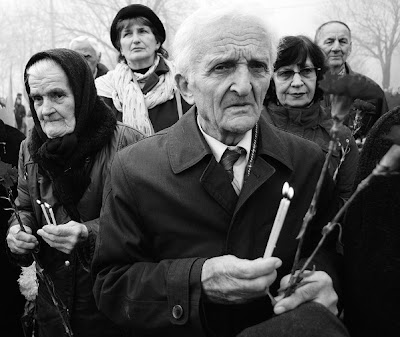 |
| photo taken from the Kyiv Post |
Holodomor, translating to "death by famine," refers to the genocide committed against the Ukrainian people between 1932-1933, under Stalin's rule. During this time, a resurgence of Ukrainian nationalism had grown across the country. Due to Ukraine's geopolitical pull in the Soviet Union, this national identity was very dangerous to Stalin's regime. To overcome this threat, an artificial famine was induced. Farmers were required to submit impossible quotas of grain to the government. Meat, potatoes, and other crops were taken as penalty of not submitting the required amount of grain. Starving villages that could still not make quotas were "blacked out," meaning trade was prohibited and no one was allowed to enter or leave. Families literally starved to death next to locked containments of food. In addition to starvation, wide-spread deportations and executions occured among academics, writers, clergyman, and farmers who would not submit.
Through massive purges, the famine was systematically concealed from the rest of the world. And while the scale of this event is unfathomable, during the years of Yushchenko's presidency (2005-2009), several archives of the famine, such as the Soviet Secret Police files, were made available for researchers. It is now estimated that at the height of the famine, Ukrainians were dying of starvation at a rate of 25,000 a day, totaling around 10 million over the course of this year. During this time, 1.7 million tons of grain were exported from Ukraine, Europe's bread basket.
While these tragedy of these numbers rival only the Holocaust, many do not recognize the Holodomor as a genocide. Most concerning among these are Russia and Ukraine's current political leaders, who write these deaths off as effects of drought or natural catastrophe. The victims of this atrocity and the Ukrainian people in general have incurred a great deal of hardships. It is imperative we do not let their plights go unnoticed.
